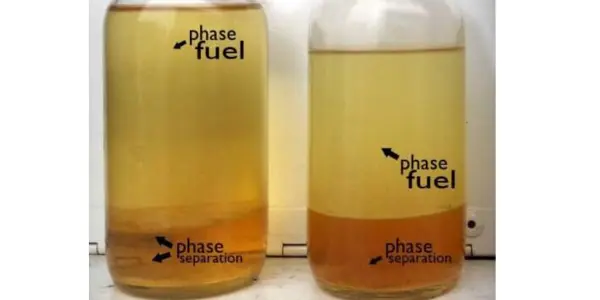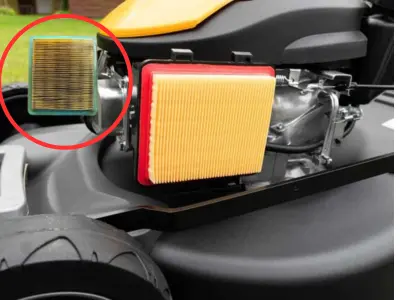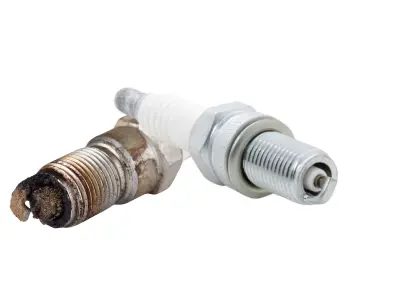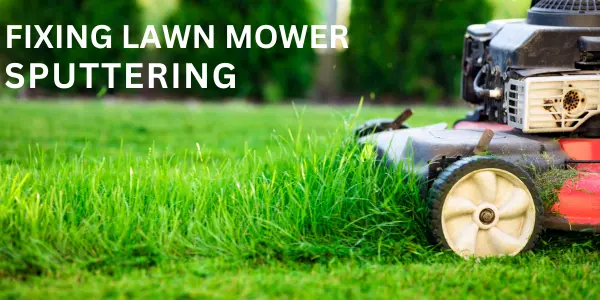Dealing with a lawn mower sputtering issue can be a real headache, especially when you’re trying to keep your yard in top shape. It’s crucial to tackle this problem head-on to maintain optimal mower performance and prevent further damage. In this thorough guide, we’ll go into the root causes of lawn mower sputtering and provide step-by-step solutions to help you troubleshoot and resolve the issue effectively.
Let’s Understand Sputtering
Lawn mower sputtering is described by the irregular, jerky movement of the mower engine, often accompanied by a popping or coughing sound. This phenomenon indicates a disruption in the combustion process, leading to decreased power output and performance. Sputtering can occur intermittently or persistently, depending on the underlying cause.
What Makes Lawn Mower Sputtering
Lawn mower sputtering can arise from various factors, ranging from fuel-related issues to mechanical problems. Understanding these underlying causes is crucial for effective troubleshooting and resolution. Let’s go deeper into each potential cause:

Stale or Contaminated Fuel
Stale or contaminated fuel is a common culprit behind lawn mower sputtering. Over time, gasoline can degrade, forming varnish and deposits that clog fuel lines and carburetor jets. Additionally, water or other contaminants may enter the fuel tank, further disrupting the combustion process.
How To Fix⚙️
To tackle this issue, prioritize the use of fresh, clean gasoline and avoid storing fuel for extended periods. Consider adding a fuel stabilizer to prevent fuel degradation, especially during off-season storage. Regularly inspect the fuel tank for remains or water and promptly drain any contaminated fuel.

Dirty or Clogged Air Filter
A dirty or clogged air filter can hinder airflow to the engine, disrupting the air-fuel mixture ratio and causing sputtering. Dust, dirt, and waste tend to accumulate on the air filter over time, impeding proper combustion and engine performance.
How To Fix⚙️
To address this issue, make it a habit to inspect the air filter regularly and clean or replace it as needed. Most air filters can be easily removed and cleaned with soap and water or replaced with a new filter. Ensure that the air filter housing remains free of debris and properly sealed to prevent contaminants from entering the engine. Opt for high quality foam or pleated paper air filters for optimal performance and longevity.
💡Opt for high quality foam or pleated paper air filters for optimal performance and longevity.

Spark Plug Issues
The spark plug plays a crucial role in igniting the air-fuel mixture in the combustion chamber. Worn or fouled spark plugs can lead to misfiring, resulting in sputtering and reduced engine performance. Common issues include worn electrodes, fouling from carbon deposits, and damaged insulators.
How To Fix⚙️
To tackle spark plug issues, remove the spark plug and inspect it for signs of wear, fouling, or damage. Clean the spark plug using a wire brush or replace it with a new plug if necessary. Ensure that the spark plug gap is set to the manufacturer’s specifications and reinstall it securely.
Carburetor Problems
The carburetor is responsible for mixing air and fuel in the correct ratio for combustion. Malfunctions such as a stuck float, clogged jets, or dirt and small waste particles in the carburetor can disrupt fuel delivery and lead to sputtering.
How To Fix⚙️
To troubleshoot carburetor problems, carefully remove the carburetor from the engine and disassemble it. Clean the carburetor thoroughly using carburetor cleaner and compressed air, paying close attention to the jets, float bowl, and fuel passages. Inspect the carburetor gaskets and O-rings for damage and replace them if necessary. Reassemble the carburetor and reinstall it on the engine, ensuring proper alignment and tightness of all components.
Fuel Line Blockage
A blockage in the fuel line can restrict fuel flow to the engine, causing sputtering and stalling. Common causes of fuel line blockage include dirt or rust buildup in the fuel tank or fuel line.
How To Fix⚙️
To address this issue, inspect the fuel line for signs of blockage or damage. Remove the fuel line and flush it with clean fuel or compressed air to remove any obstructions. Inspect the fuel tank for debris or contaminants and clean it thoroughly if necessary. Replace any damaged or deteriorated fuel lines to ensure proper fuel flow to the engine.
Related Article: Selecting the Right Gas for Your Lawn Mower
Ignition System Problems
Issues with the ignition system can also contribute to lawn mower sputtering. Faulty ignition coils, ignition modules, or ignition switches can cause intermittent spark or no spark at all, leading to engine misfires and sputtering.
How To Fix⚙️
To diagnose ignition system problems, inspect the ignition components for signs of damage or wear. Test the ignition coil and module using a multimeter to ensure proper functionality. Check the ignition switch for continuity and proper operation. Replace any faulty ignition components to restore proper spark and engine performance.
Mechanical Issues
In some cases, mechanical problems within the engine can cause sputtering. These may include worn piston rings, valve clearance issues, or compression loss due to engine wear or damage.
How To Fix⚙️
To address mechanical issues, perform a comprehensive inspection of the engine components. Check the piston rings and cylinder walls for wear or damage. Inspect the valves and valve seats for proper seating and clearance. Perform a compression test to assess engine compression and identify any potential issues. Repair or replace worn or damaged engine components as needed to restore proper engine performance and eliminate sputtering.
Tips To Avoid Sputtering in the Future💡
- Fuel Selection:
- Use the correct type of fuel recommended by the mower’s manufacturer. Using ethanol-blended fuel can lead to sputtering issues in some mowers, so opt for ethanol-free gasoline if available.
- Avoid using old or stale fuel, as it can lead to clogging of fuel lines and carburetor jets. Always use fresh, clean gasoline for optimal engine performance.
- Regular Maintenance:
- Implement a regular maintenance schedule for your lawn mower, including tasks such as oil changes, air filter cleaning or replacement, and spark plug inspection.
- Keep track of maintenance intervals and adhere to them diligently to prevent potential issues that can lead to sputtering.
- Proper Storage:
- Store your lawn mower in a clean, dry area, away from moisture and extreme temperatures. Use a mower cover to protect it from dust and waste when not in use.
- Before storing your mower for an extended period, consider draining the fuel tank or adding a fuel stabilizer to prevent fuel degradation and clogging of fuel lines.
- Blade Maintenance:
- Regularly inspect the mower blades for signs of wear, damage, or dullness. Sharpen or replace the blades as needed to ensure clean, even cuts and reduce strain on the engine.
- Check the blade alignment and ensure that they are properly balanced to prevent excessive vibration, which can contribute to sputtering.
- Cooling System Maintenance:
- Inspect the cooling fins and air vents around the engine for any obstructions or debris buildup. Clean them regularly to ensure proper airflow and prevent overheating.
- Monitor the engine temperature gauge or warning lights while mowing and stop immediately if the engine begins to overheat. Allow it to cool down before continuing to prevent damage.
- Tire Pressure:
- Check the tire pressure regularly and maintain it at the recommended level. Improper tire pressure can affect mower stability and performance, leading to uneven cuts and potential sputtering.
- Engine Speed Adjustment:
- Periodically check the engine speed settings and adjust them as needed to match the mowing conditions and terrain. Running the engine at the correct speed helps prevent strain and overheating, reducing the likelihood of sputtering.
- Inspect Electrical System:
- Regularly inspect the battery, wiring, and electrical connections for signs of damage or corrosion. Clean and tighten connections as needed to ensure proper electrical conductivity and prevent starting issues.
- Keep Surroundings Clean:
- Clear the mowing area of any large obstacles, rocks, or branches before starting to prevent damage to the mower blades and potential sputtering caused by obstructions.
- Professional Inspection:
- If you’re unable to diagnose or resolve the sputtering issue on your own, consider seeking professional help from a qualified lawn mower technician. They can perform a thorough inspection and provide expert advice on repairs or maintenance.
Conclusion
Addressing lawn mower sputtering issues requires thorough troubleshooting and attention to detail. By understanding the causes of sputtering and following the provided solutions and preventive maintenance tips, you can ensure the smooth and reliable operation of your lawn mower. Remember to prioritize regular maintenance and prompt repairs to keep your mower running at its best.

